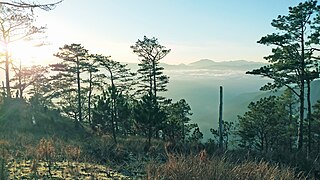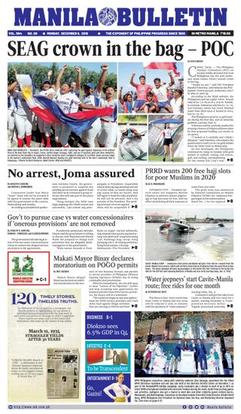
Ilocos Sur, officially the Province of Ilocos Sur, is a province in the Philippines located in the Ilocos Region in Luzon. Located on the mouth of the Mestizo River is the capital of Vigan. Ilocos Sur is bordered by Ilocos Norte and Abra to the north, Mountain Province to the east, La Union and Benguet to the south and the South China Sea to the west.

Ilocos Region is an administrative region of the Philippines, designated as Region I, occupying the northwestern section of Luzon and part of Central Luzon plain, primarily by Pangasinan. It is bordered by the Cordillera Administrative Region to the east, the Cagayan Valley to the northeast and southeast, and the Central Luzon to the south. To the west lies the South China Sea.

Caoayan, officially the Municipality of Caoayan, is a 4th class municipality in the province of Ilocos Sur, Philippines. According to the 2020 census, it has a population of 19,574 people.

Galimuyod, officially the Municipality of Galimuyod, is a 4th class municipality in the province of Ilocos Sur, Philippines. According to the 2020 census, it has a population of 10,244 people.
Ilocano literature or Iloko literature pertains to the literary works of writers of Ilocano ancestry regardless of the language used - be it Ilocano, English, Spanish or other foreign and Philippine languages. In Ilocano language, the terms "Iloko" and "Ilocano" are different. Generally, "Iloko" is the language while "Ilocano" refers to the people or the ethnicity of the people who speak the Iloko language.
GUMIL Filipinas or Ilokano Writers Association of the Philippines, is one of the most active group of regional writers in the Philippines. It has hundreds of active writer-members in provincial and municipal chapters as well as in overseas chapters in the mainland U.S. and Hawaii and in Greece.
Reynaldo A. Duque was a multilingual Ilocano writer who was the editor-in-chief of Liwayway magazine, the leading Filipino (Tagalog) weekly magazine in the Philippines. He was a fictionist, novelist, poet, playwright, radio/TV/movie scriptwriter, editor, and translator.
Liwayway is a leading Tagalog weekly magazine published in the Philippines since 1922. It contains Tagalog serialized novels, short stories, poetry, serialized comics, essays, news features, entertainment news and articles, and many others. In fact, it is the oldest Tagalog magazine in the Philippines. Its sister publications are Bannawag, Bisaya Magasin, and Hiligaynon.

The Ilocanos, Ilokanos, or Iloko people are the third largest Filipino ethnolinguistic group. They mostly reside within the Ilocos Region, in the northwestern seaboard of Luzon, Philippines. The native language of the Ilocano people is the Ilocano language.

The Manila Bulletin is the Philippines' largest English language broadsheet newspaper by circulation. Founded in 1900, it is the second oldest extant newspaper published in the Philippines and the second oldest extant English newspaper in the Far East. It bills itself as "The Nation's Leading Newspaper", which is its official slogan.
Bisaya Magasin is a weekly Cebuano magazine now published by the Manila Bulletin Publishing Corporation, Philippines. It has the record of being the oldest magazine in Cebuano which is still published, and "the most successful periodical in Cebuano".

The Archdiocese of Nueva Segovia is an archdiocese of the Catholic Church in the Philippines. It covers the province of Ilocos Sur, on the island of Luzon. The see of the archdiocese is the city of Vigan.
Gregorio "Greg" C. Laconsay is a Filipino-Ilocano editor and writer in the Philippines. He was the former editor in chief for two prominent literary magazines in the Philippines, namely the Ilocano-language Bannawag and the Tagalog-language Liwayway.
Hiligaynon is the leading Ilonggo weekly magazine published in the Philippines since 1934. It contains Ilonggo serialized novels, short stories, poetry, serialized comics, essays, news features, entertainment news and articles, and many others. Hiligaynon is named after one of the most predominantly spoken language amongst the people of Western Visayas and Soccsksargen region. Hiligaynon closed during the notorious Martial Law era, but was resurrected in 1989.
José Garvida Flores was an Ilocano poet and playwright, from Bangui, Ilocos Norte, Philippines.
Juan S.P. Hidalgo Jr., is an Ilokano fictionist, poet, editor, translator, and painter. He was former managing editor of Bannawag, a weekly Ilokano magazine. During his 37-year stint (1961–1998) as senior literary editor at Bannawag, he guided, encouraged and trained young and old Ilokano writers to produce quality Iloko literary works. He was among the recipients of the first ever Philippine-International Theater Institute-National Commission for Culture and the Arts Award for Culture-Friendly Media Institutions.
Antonio "Tony" Velasquez is a Filipino illustrator regarded as the Father of Tagalog comics and as the pioneer and founding father of the Philippine comics industry. He was the creator of Kenkoy, an “iconic Philippine comic strip character”.

Ilocano is an Austronesian language spoken in the Philippines, primarily by Ilocano people and as a lingua franca by the Igorot people and also by the native settlers of Cagayan Valley. It is the third most-spoken native language in the country.
Pamulinawen is a popular old Ilocano folk song possibly from the pre-Spanish era. It is about a girl with a hardened heart. who does not need her lover's pleading. It is about courtship and love.







